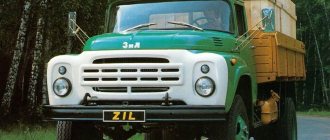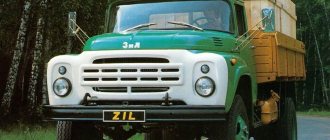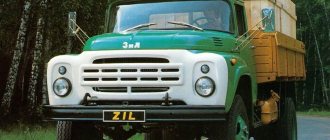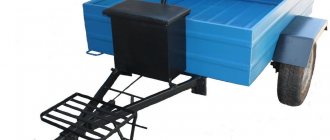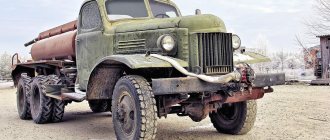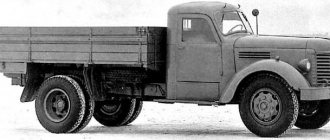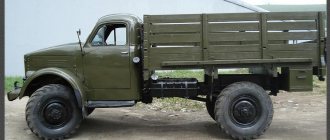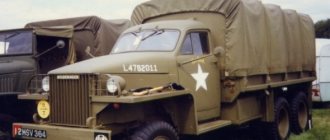We can talk about the legendary ZIL 130th model for hours. It all started in the post-war years, when the Soviet Union needed equipment for agricultural needs. This Soviet, and later Russian car, replaced the old ZIL-164 model, which was initially produced as the ZIS-150. Before the model became what we know it to be, quite a few changes were made to it. Before the restructuring of the Stalin plant, the model was produced as the ZIS-125.
As a product of the Likhachev plant, it was produced from 1962 to 2010. Initially, assembly was carried out in Moscow, but in the 90s the facilities were moved to Novouralsk. There the car was produced under a different name, Amur. It is noteworthy that the ZIL-130 became the first truck of its kind to be painted white and blue. Before this, all ZILs were painted khaki, since they were created for military purposes. The entire ZIL model range.
Appearance
The foreshadowing versions of ZIL trucks were extremely unfinished and crude. The justification is compelling; a large amount of equipment was required to repair damage after the war. But in the end, already in 1956, prototypes were significantly more beautiful than their predecessors.
After a number of regular changes, which concerned both the restyling of the truck and the plant itself, the ZIL-130 was presented at the annual international fair in Leipzig, where it received a gold medal, and the engineers received many diplomas. Since that time, the “130” model began to gain unprecedented popularity.
The fact is that ZIL dump trucks had quite a lot of modifications. The most commonly used of these were semi-trailers and articulated dump trucks. The most significant modifications were made in 1966 and 1977. On the basis of the usual “one hundred and thirty”, fire engines and truck cranes, tank trucks and vans, flatbed vehicles and construction dump trucks were created.
The car is efficient even in cramped urban environments thanks to its turning radius of up to 7 meters. Having a carrying capacity of only 3 tons, the ZIL-130 itself weighs at least 4 tons. At the same time, it can be used to tow a trailer weighing no more than 8 tons. From the outside, the Russian truck looked very good for that time. The car was capable of attracting attention.
It was painted white and blue. Before the ZIL-130, all automobile enterprises worked only for the defense and army spectrum, based on this, the car had a protective paint. The hood was alligator style. ZIL received streamlined wings and a panoramic windshield. In addition, the cabin was equipped with a ventilation hatch and windows.
Body
The body was supplied with a folding tailgate and was considered a cargo-passenger one. The gratings located on the sides were equipped with benches that could be folded back. They could fit 16 people. There was also a bench that could be removed - it could seat 8 people.
The basic modification of the ZIL-130 includes an awning along with arches, which can be removed and installed at any time. The body design is also practical. The height of the floor of the cargo compartment of the ZIL-130 is similar to the height of the floor in railway cars. This fact greatly simplifies the loading and unloading process.
Additional equipment included blackout for military versions, canisters, an ax, and a shovel.
Modifications of ZIL-5301 “Bychok” cars
The low loading height of the Bychkov (765 mm), good load capacity with compact dimensions, small turning radius and excellent maneuverability were very soon appreciated by many consumers in Russia and the CIS. Further development of the concept of this vehicle, as well as real support from the capital’s authorities, made it possible to create a number of cargo and cargo-passenger modifications on its basis; various special vehicles.
In particular, at one time “Bychki” with an extended cabin equipped with a berth were in considerable demand. This proved that the ZIL-5301 is in demand, applicable and cost-effective not only on intracity, but also on short- and medium-range intercity routes.
Based on the Bychka, a whole family of small ZIL-3250 buses was created, including 15 and 19-seat modifications (with a base of 3650 and 4505 mm, respectively); as well as a ZIL-32502M ambulance with a single-pitch tire and pneumatic rear axle suspension, and a ZIL-325SHA staff bus. The buses received stabilizers for both suspensions and an anti-lock braking system (ABS).
ZIL-5301 “Bull” with an extended cabin with a sleeping bag.
Brief overview of the main modifications:
- ZIL-5301AO – basic version of the model;
- ZIL-5301BO – chassis adapted for installation of special equipment, superstructures and all-metal bodies (including cash-in-transit and fire-fighting bodies);
- ZIL-5301GO and ZIL-5301PO – special isothermal vans, based on the ZIL-5301BO version;
- ZIL-5301DO - an extended version of the classic basic ZIL-5301AO;
- ZIL-5301EO - an extended model used for installing special bodies and equipment;
- ZIL-5301IO - extended isothermal van;
- ZIL-5301TO – 2-cabin extended chassis based on ZIL-5301DO, designed for mounting a wide range of special equipment and bodies;
- ZIL-5301YUO is a long-wheelbase modification with two berths in an extended cabin.
Cabin interior
The steering mechanism of the ZIL-130 was a screw with a special spherical nut plus a piston-rack. The hydraulic booster was built-in. The three-seater cabin is located immediately behind the engine. The seat is adjustable in length, height and backrest tilt. The main options in the cabin included a heater, a windshield wiper with two blades, and a glass washer. For the 60s, the cabin ergonomics are at the highest level. The instrument panel and functional instruments are located very conveniently for the driver.
The designers provided two ventilation hatches in the cabin roof. The radiator grille has become a memorable element. The cabin was made of solid metal and had three seats. The engineering staff did a great job, because the car was comfortable and was very different from many Soviet trucks. Drivers received improved conditions for performing their work.
It was much more comfortable to sit inside, because the changes also affected the width - it was increased by 1.2 meters when compared with the ZIL-164 model. Instruments and controls were optimally located in the spacious cabin. In addition, soft seats appeared - for the driver and for passengers (double). The driver's seat could now be adjusted in horizontal and vertical directions.
It was also possible to change the angle of the chair back and pillows. It was on the ZIL-130 that the hydraulic power steering wheel debuted. Thanks to this, not only the ease of driving the truck increased, but also its safety - if the front wheel broke, it was easier to keep the truck on the road.
Device
The prototype of the car was the Mercedes Vario. The design of the ladder-type frame with channel-section side members was borrowed from its German “brother.” This made the “bull” as safe as possible (even in a head-on collision, the car frame did not fold). There is a special device at the front for towing the car.
The brake system is 2-circuit, each circuit is independent. The first circuit brakes the left rear and right front wheels, the second - the other two wheels. This ensures road safety. In case of problems with one of the circuits, the driver can perform emergency braking. The brakes are operated hydraulically. Front brakes are disc, rear brakes are drum. The car is also equipped with a standard mechanical handbrake. The latest versions of ZIL 5301 are equipped with ABS.
The ZIL 5301 uses a 5-speed manual transmission with a hypoid main gear. The clutch is a standard disc clutch in an oil bath. In all gears except first and third, the synchronizer works. The main transmission mechanism is a cardan transmission with 3 joints and an intermediate support.
The base model is equipped with standard stamped discs made of high-strength metal. The alloy is characterized by great hardness, allowing it to withstand extreme loads without losing shape. Their use on this truck is absolutely justified. Along with the wheels, classic tubeless tires 227/75R16C are used. When unloaded, the impact of the axles on the road surface is approximately equal.
The cabin and interior of the car are very comfortable, although most of the elements have an unpretentious appearance. The driver's seat is adjustable in several ways and is very soft. Its casing is made of durable material. The cabin has good sound and heat insulation, allowing you to move comfortably in winter (a powerful stove heats the interior well even in cold weather). ZIL 5301 models are equipped with power steering, which simplifies maneuvering. In addition to standard cabs, extended versions with a sleeper and a hatch are available.
Thanks to the simplicity and reliability of the design, “Bychok” has become very popular among Russians. Most car components can be repaired even on the road. However, the model also has serious drawbacks.
Dimensions and weights
- Length: 6.195 m (7.165 m - extended version); Width: 2.319 m; Height: 2,365 m.
- Wheelbase: 3,650 m.
- Front track: 1.832 m; Rear track: 1,690 m.
- Ground clearance: 180 mm.
- Turning radius: 7.8 meters.
- Load capacity: 3 tons.
- Parameters of the onboard cargo platform as standard: 3750x2254x450 mm.
- Loading height: from 765 mm to 1050 mm.
- Weight: loaded (with awning) – 3695 kg; Full (permissible) – 6950 kg.
- The permissible load on the front axle is 2350 kg.
- The permissible load on the rear axle is 4900 kg.
- Disc wheels, 6.5Jx16H2; Tubeless tires “225/75R16С”.
Cabin and body
In order to reduce the cost, Bychka used design solutions previously used on products of the Likhachev Automobile Plant. Thus, the car received a spacious ZIL-4331 cabin, complemented by expressive headlights and an unusual “tail”.
For public utilities, the company created a 4-door, 2-row cab with 6 passenger seats. And already from the very beginning, the ZIL-5301 had a whole “bouquet” of problems and chronic “illnesses” characteristic of many domestic cars.
Serious difficulties usually begin from the cabin: the engine can be heard even at low speeds, noise and heat insulation is low, after a few minutes in cold air the cabin becomes very cold, and the paint peels off the hood within a few months of use.
The “stove” in the car functions quite reliably, but the Rzhev heater, which is installed as an option, has low durability. Drivers like the ventilation hatch that appeared in the cabin, but it leaks regularly, and the high beam is low-effective.
However, the cabin is not the sore point of the Bull, and this element is often praised. Among other things, the driver’s workplace also has positive aspects. The seat is especially comfortable - it is adjustable and extremely soft. The textile covering is made of a very durable material that is difficult to get dirty.
Also, in the latest versions, the car’s shortcomings regarding the cabin have been significantly reworked. Now the driver's cabin has excellent thermal and sound insulation, which allows you to move comfortably in winter - a powerful stove will prevent the driver and passenger from freezing even in severe frost.
The steering wheel is two-spoke, large in diameter. Thanks to this parameter, as well as the presence of power steering, driving the car becomes quite simple - when performing a maneuver, you need to rotate the steering wheel to the very minimum.
In addition to standard cabs, extended versions with a sleeper and a hatch are available.
Distinctive features of ZIL-5301 “Bychok”:
- Tail with a small hood that opens to the rear;
- Double non-adjustable passenger seat;
- Three-seater two-door cabin, built on the basis of the ZIL-4331 model;
- Heater combined with engine cooling system;
- Separate driver's seat with a suspension mechanism, adjustable stiffness and settings for the cushion, backrest and position;
- Three-blade power windshield wiper and power windshield washer.
Specifications
The ZIL-130 car was initially equipped with an eight-cylinder 4-stroke engine with a capacity of 148 horsepower (3000 rpm). The working volume reached 6 liters. The engine lubrication system was combined, with splash and pressure. The engine power supply system is forced, the cooling system is liquid.
The suspension was dependent, the frame consisted of steel spars with five cross members. Starter 1.5 hp turned on via a traction relay. Known to everyone, the ZIL-130 truck became a breakthrough in Soviet mechanical engineering. Along with it, three-seater cabins, a hydraulic power steering wheel, a gearbox that included helical gears and synchronizers, an engine pre-heater, glass washers and more appeared.
Power unit
ZIL-130 acquired a power unit, the design of which had much in common with the motor from the ZIL-111 modification. It was a V-shaped eight-cylinder engine, but with a smaller displacement, which was designed for 76 gasoline, which was already familiar at that time. The engine came with a 2-chamber K-88AE carburetor, with a falling flow, and a balanced float chamber. There was a rev limiter.
From the very beginning, an experimental type engine was proposed, which was carburetor and had a V-shaped cylinder arrangement. The volume was 5.2 liters. Such an engine was capable of developing up to 135 horsepower and 3200 rpm. The camber of the cylinder block was 90 degrees. However, during the debut tests it became clear that such power would not be enough and the ZIL-130 truck simply would not be able to achieve good dynamics.
Then work began on using 8 cylinders in the same V-shape. Such improvements made it possible to increase engine power to 150 horses. It was then that the decision was made to curtail the production of 6-cylinder units. The new engine allowed the car to reach speeds of up to 90 km/h. The valve position on this 4-stroke engine was at the top. The engine capacity was 6.0 liters and 3,000 rpm.
In 1974, it was decided to use a more economical engine type for some models. Thanks to this replacement, the truck's efficiency also increased. This unit was a ZIL-157 with 6 cylinders arranged in a row, the power was 110 horsepower. The engine continued to be powered by A-72 gasoline.
The device used an economizer design and a mechanical pump for acceleration. It is equipped with a pneumatic crankshaft speed regulator, which is centrifugal. Engine lubrication is carried out in a combined cycle. In practice, this occurs using pressure, spraying oils. At the initial stage, this mechanism included a device for deep filtration. It looked like a set of thin plates made of steel. For enhanced purification, a jet-driven centrifuge was used.
The fuel pump provided forced fuel to the engine.
It was designed like the B-9 diaphragm with a single exhaust valve and a pair of intake valves. The crankcase blower function is of a closed type. 2-stage air purification is carried out using a VM-16 filter. This engine was quite gluttonous - for a hundred it could eat from 30 - 40 liters. It is clear that at that time this was not a problem, since fuel cost a penny. But today, many truck owners have had to redesign their vehicles in order to reduce operating costs. A full 170-liter tank was only enough for 445 kilometers. Technical characteristics of diesel variations of ZIL
| Model | ZIL-MMZ-554 | ZIL-MMZ-555(A) | ZIL-MMZ-555K |
| Basic chassis | ZIL-130B/ZIL-130B2 | ZIL-130D(ZIL-130D1) | ZIL-130K |
| Engine | ZIL-130 | ZIL-130 | ZIL-157 |
| Engine horsepower | 150 | 150 | 110 |
| Engine power in kilowatts | 110,4 | 110,4 | 80,9 |
| Maximum torque(Newton meters) | 401,8 | 401,8 | 343 |
| Maximum speed | 90 | 90 | 90 |
| Fuel consumption N liters per 100 kilometers | 37 | 37 | 37 |
| Gearbox type | 5-speed manual | ||
| Dimensions | |||
| Wheelbase | 3 800 mm. | 3 300 mm. | 3 300 mm. |
| Car dimensions | |||
| Length | 6,675 mm. | 5 475 mm. | 5 475 mm. |
| Width | 2,500 mm. | 2,420 mm. | 2,420 mm. |
| Height | 2 400 mm. | 2,510 mm. | 2,510 mm. |
| Platform dimensions | |||
| Length | 3,752 mm. | ||
| Width | 2 325 mm. | ||
| Height | 575 mm. | ||
| Square | 8.7 m3 | ||
| Body volume m3 | 5 | 3 | 3 |
| Body lift angle | 50o | 55o | 55o |
| Wheel formula | 4*2 | 4*2 | 4*2 |
| Tire size | 260-508Р | 260-508Р | 260-508Р |
| Technical dimensions of truck cranes ZIL-130 KS-2561D and KS-2561DA | |||
| Base | ZIL-130 | ||
| Switch installation type | Main | Non-retractable boom | |
| Replaceable | With extended boom, with extended boom and jib | ||
| Main boom length | 8 m. | ||
| Departure | 3.3 – 7 m. | ||
| System load capacity | 1,6 | ||
| Ascent/Descent Speed | 02 – 5.3 m/s | ||
| Maximum lift height | 15 meters | ||
| Dimensions with boom lowered | |||
| Length | 10 600 mm. | ||
| Height | 3 650 mm. | ||
| Width | 2,500 mm. | ||
| Weight | 8.8 tons | ||
By the end of the 1980s, it became clear that it was extremely irrational for trucks to drive on gasoline. In order to switch the ZIL to cheaper fuel, all efforts were devoted to a new modernization of the engine. But unfortunately, it did not go further than testing and prototypes.
Gearbox and clutch
The car has a rear-wheel drive axle, uses a dry clutch with a single disc and a mechanical five-speed gearbox with a pair of synchronizers (in 2nd and 3rd and 4th and fifth gears) with constant gear mesh, except for 1st and reverse. This unit was new in the automotive industry and has undergone improvements.
The gearbox transmits torque from the engine to the rear axle using a driveshaft. The standard 130 and the extended one had two shafts with an intermediate support, which was attached to the frame. And the model with a short base was supplied with a single shaft that did not require an intermediate support.
The mechanical gearbox was designed in 1961. Already 6 years later, in 1967, the gearbox structure underwent minor changes - it was expected and it happened, the appearance of a front bearing for the driven shaft, the shaft journal changed its design. Instead of a needle type bearing, a separator was installed.
The restyled box did not have a retaining ring. In order to avoid water getting into the gearbox when the car is wading or during heavy rainfall, the gear shift knob has become insulated with a rubber seal, the shape of which resembles a cover and a clamp.
And a special paste allowed manufacturers to protect the gearbox and hatch covers, the surface of the oil sump and other parts of the device. Everything inside is ventilated using a ventilation tube. The box housing itself was made of the best cast iron, which significantly increased its service life. Hydraulic shock absorbers are used on the front axle, and telescopic shock absorbers on the rear axle.
Brake system
The ZIL-130 truck is equipped with drum-type brakes on all wheels. They operate under the influence of a pneumatic system. The air reserve is stored in a specialized tank under the pressure provided by a mechanical compressor.
It is brought into its operating position by the belt drive water pump pulley. The operation of a 2-cylinder compressor is 2000 rpm, which is 220 liters per minute. It is liquid cooled. The number of air cylinders is 2 pieces, 20 liters each. The parking brake also uses a drum that blocks the driveshaft.
Electrical system
The voltage of the electrical system is 12 volts. Power is supplied from a 6ST-90-EM battery. The number 90 in the name indicates the amount of AmCh. There were two types of generators: the most common 32.3701 (also found on trucks from other manufacturers, for example, KamAZ), provides a current of 60 amperes; for ZIL-157D the package included G108-V with a power of 60A.
The voltage regulator is PP350-A (3702), non-contact, semiconductor. The starter is ST130-AZ, found not only in ZIL products. Ignition distributor - R-137, with automatic ignition timing control through centrifugal vacuum regulators. Ignition coil – B114-B. Spark plugs – A11 with M14*12.5 thread.
Dimensions
The dimensions of the ZIL-130 are as follows: length – 6,672 mm, width – 2,500 mm, height – 2,400 mm. Ground clearance – 275 mm. Wheelbase – 3,800 mm. Rear track – 1,790 mm. Front track – 1,800 mm. The minimum turning radius is 8,900 mm. The body platform is 5.10 cubic meters in volume. The floor area is 8.72 square meters. Platform dimensions: width – 2,326 mm; length – 3,752 mm; height – 575 mm.
Engine Description
The truck in question was equipped with several types of engines at different times:
- MMZ D-245.12S (Euro 0);
- MMZ D-245.9 E0 (Euro 0);
- MMZ D-245.9 E2 (Euro 2);
- MMZ D-245.9 E3 (Euro 3).
From April 2008 to the present day, all ZIL-5301 models are equipped with engines that meet Euro 3 requirements in terms of their environmental qualities.
Do you know due to what technical characteristics the MAZ-53366 is not only in demand among consumers, but has also been in production from 1978 to the present? After reading this article, you will be convinced that buying a used Hovo dump truck in many cases is much more profitable than purchasing a new one.
The MMZ D-245.9 engine has the following characteristics:
- type – diesel, four-stroke;
- cooling – liquid (antifreeze);
- formation of the fuel mixture - direct injection;
- total number of cylinders – 4 pcs.;
- cylinder diameter – 110 mm;
- piston stroke length – 125 mm;
- total combustion chamber volume – 4.75 l;
- compression (calculated value) – 15.1;
- the maximum possible power at rated speed is 136 hp. With. (100 kW);
- crankshaft rotation speed – 2,400 rpm;
- fuel consumption – 215 g/kW;
- torque (maximum) – 460 N×m;
- weight – 430 kg (dry), 500 kg (with filling fluids).
The engine in question, among other things, is equipped with a turbocharger - this is one of the reasons for such high power. The design involves cooling the air before blowing (intermediate).
The overall dimensions of the motor are relatively small, despite years of development:
- length – 1,016 mm;
- height – 1,035 mm;
- width – 719 mm.
Consumption is approximately 12 liters for every 100 km at a speed of no more than 60 km/h.
“Bychok” is quite fast and can compete even with its foreign counterparts: the maximum speed with maximum load, according to the accompanying documentation, is 95 km/h.
The actual speed of this car is slightly higher. The ZIL-5301 accelerates to 60 km/h in 30 seconds.
Options and prices
Most car enthusiasts buy these trucks and turn them into masterpieces. On the Internet you can find many photographs of ZIL after its upgrade. You can buy a real Russian truck for a very modest price - from 35 to 50,000 Russian rubles.
It is clear that their general and technical condition is not ideal, but it is quite easy to purchase the necessary spare parts for the car. Those cars that have been preserved in good condition are sold a little more expensive, the cost can reach up to 380,000 rubles.
Options
On the platform of the ZIL-130 truck, the automobile plant produced cars:
- ZIL-130G - was produced for the transportation of various large cargo and low-density elements, as well as for towing a trailer, the total weight category of which does not exceed 8 tons. The vehicle itself is capable of transporting up to 6 tons of cargo (wheelbase 4,500 mm);
- ZIL-130V1 is a truck-type tractor designed for towing various semi-trailers, the total weight of which (this also includes the weight of the semi-trailer) is no more than 14.4 tons on hard road surfaces (wheelbase 3,300 mm);
- ZIL-130D1 – platform for building the ZIL-MMZ-4502 and ZIL-MMZ-555 dump truck; coped well with transporting trailers;
- ZIL-130D2 – a platform with a pneumatic outlet and a towing device, which is intended for the construction of a dump truck-tractor ZIL-MMZ-45022;
- ZIL-130B2 is also a platform with a pneumatic outlet, only for a trailer and a towing device, which was intended for the construction of a ZIL-MMZ-554M dump truck tractor for agriculture.
Apart from those that were not mentioned, the production could produce complete sets of machines that were intended for operation in different climates. Any similar model of the 130th has its own letter or digital code. The operating time of the machine and its reliability, as well as economic indicators, largely depend on the grinding of parts during the first time of operation.
Initially, the plant planned to produce the following standard models:
- ZIL-130A was the release of an onboard tractor for full operation with a trailer, the total weight of which is 8 tons. It is equipped with a combination brake valve, towing device and pneumatic and electrical connections for connecting the brake system and electrical devices of the trailer;
- ZIL-130G – long-wheelbase platform truck with 2 sectional side walls (wheelbase 4,500 mm);
- ZIL-130V – truck-type tractor with a short wheelbase (3,300 mm);
- ZIL-130VT is a truck-type tractor with a short wheelbase (33 cm) and a stronger rear axle;
- ZIL-130D – platform for a construction dump truck with a short wheelbase (33 cm);
- ZIL-130B is a platform for an agricultural dump truck with a wheelbase of 3,800 mm.
- ZIL-MMZ-555 – dump truck with rear loading. Built on the basis of ZIL-130D1. Due to the shortened wheelbase, the truck has good maneuverability.
When trucks were produced, a couple of significant modernizations of the ZIL-130 division were carried out in 1966 and 1977. Following the latter, the radiator grille was changed. At the request of the customer, it was possible to install a foreign-made motor in various modifications:
- Perkins345, 140 hp.
- Valmet 411BS, has 4 cylinders and operates with a power of 125 hp
- Leyland400, the presence of 6 cylinders and diesel fuel provide a power of 135 horses.
It is also possible to install a third non-driving axle to increase the load capacity. These frauds were carried out by subsidiaries outside the plant.
Car history
The Likhachev Automobile Plant had no experience in developing cars of the class with a carrying capacity of 3000 kilograms, so the company decided to use proven developments from Daimler-Benz AG.
As a result, in 1993, a prototype “Bull” was presented, the basis for which was the units and components of the Mercedes-Benz T2, which became the predecessor of the Mercedes Vario. Domestic engineers, having studied the design of the German product, redesigned it taking into account Russian realities, market opportunities, production and road conditions.
These factors affected the model in such a way that it was impossible to call the ZIL-5301 a copy of the Mercedes-Benz T2. The car received an unusual name at the insistence of Moscow Mayor Yuri Luzhkov. In fact, if you look closely, you can really see the bull in the front of the car.
2 years later, large-scale production of the model began. The appearance of the car was vital for the company, since the demand for medium-duty trucks, in which it specialized, sharply decreased with the transition to a market economy.
Advantages and disadvantages
Pros of the car
- Record low cost of a car;
- Low requirements for the required fuel;
- Small dimensions allow for good maneuvering even on city roads;
- Good maintainability;
- It's not hard to find the parts you need;
- Good maneuverability and high ground clearance;
- Hydraulic power steering.
Cons of the car
- Minimum vehicle speed;
- Not a record carrying capacity of the machine;
- Year of issue;
- Many parts often fail;
- High fuel consumption;
- Lack of comfortable conditions in the cabin (by modern standards);
- Problems with starting in the cold season;
- Low noise insulation and thermal insulation of the interior;
- Uncomfortable chairs.
Let's sum it up
Over more than 40 years of history, the vehicle has established itself as a fairly durable and reliable truck, which is unpretentious in operation and easy to repair. The universally recognizable ZIL-130 or AMUR-53131 can still be found on Russian roads. A large number of modifications made it popular in many fields from agricultural to military. One gets the impression that he will be driving along them for decades to come.
We advise you to read the article: ZIL - the history of the auto giant
ZIL-130 photo
Read further:
Buick Electra 225 Convertible
KamAZ-4326
MAZ-503
Czech bourgeois: the history of the first generation Skoda Rapid
History of the Volga car
Mercury Cyclone
